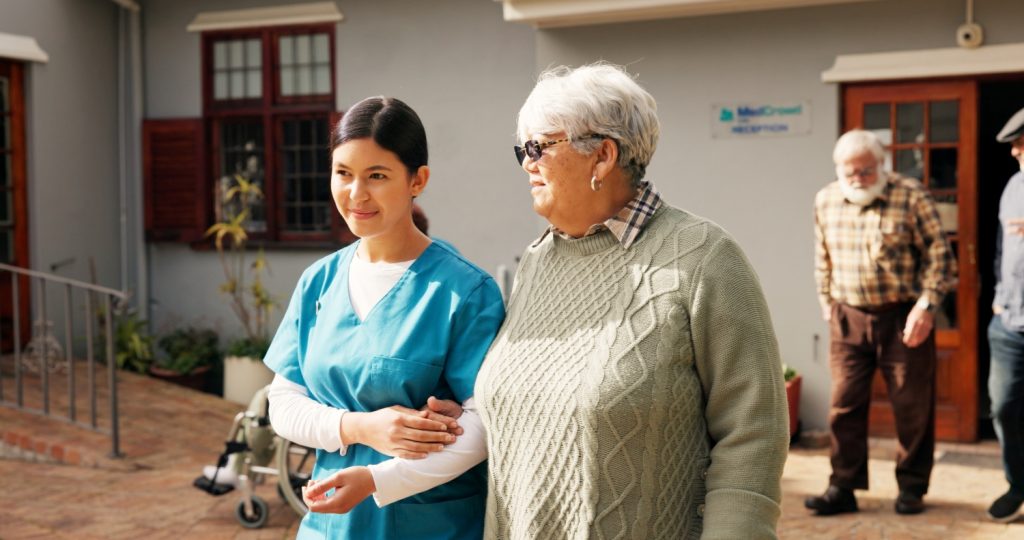Older Americans have higher rates of hospital admission, with 16.6% of those ages 65 and older hospitalized in the past year, compared to just 6.6% of adults ages 18-44. The healthcare needs of older adults differ, too, but often this is neither recognized nor are healthcare services readily adapted to reflect older adults’ preferences on what matters most.
A new Age-Friendly Hospital Measure can help hospitals better address the unique challenges of caring for an older U.S. population, which is living longer and often dealing with multiple chronic conditions.
Understanding the new measure is critical because starting this year, hospitals participating in the Hospital Inpatient Quality Reporting (IQR) Program must report on the Age-Friendly Hospital Measure or risk potential financial penalties. There also are opportunities for hospitals to leverage ongoing efforts related to other quality measures to help meet the Age-Friendly Hospital Measure requirements.
What Is the Age-Friendly Hospital Measure?
The Age-Friendly Hospital Measure focuses on improving the quality of care for patients ages 65 and older and was included in the 2025 Inpatient Prospective Payment Systems final rule adopted by the Centers for Medicare & Medicaid Services (CMS). The Measure is part of the Age-Friendly Health Systems movement that works to “ensure older adults receive safe, evidence-based care focused on what matters to them.”
‘The 5 domains are designed to ensure hospitals provide goal-centered, clinically effective care for their older patients.’
Several organizations collaborated to develop the Age-Friendly Hospital Measure, including the American College of Surgeons, the Institute for Healthcare Improvement, and the American College of Emergency Physicians. The Measure is evidence-based and evaluates a hospital’s progress in improving care for older adults in the “inpatient hospital setting, including hospital departments, operating rooms, and emergency departments.”
The Age-Friendly measure focuses on 5 essential domains:
Domain 1: Eliciting Patient Healthcare Goals. Ensuring that patients’ health-related goals and treatment preferences are obtained and respected.
Domain 2: Responsible Medication Management. Monitoring and managing medications to avoid adverse effects.
Domain 3: Frailty Screening and Intervention. Screening for frailty, including cognition impairment, malnutrition and mobility.
Domain 4: Social Vulnerability Assessment. Identifying and addressing issues like social isolation, caregiver stress and elder abuse.
Domain 5: Age-Friendly Leadership. Designating hospital leadership roles focused on age-friendly care.
The 5 domains are designed to ensure hospitals provide goal-centered, clinically effective care for their older patients. In each domain, there are individual attestation statements upon which hospitals will report. Individual hospitals’ scores on the Age-Friendly Hospital Measure will then be publicly reported on the Medicare.gov website.
The Age-Friendly Hospital Measure is based in part on the 4Ms Framework of age-friendly care, identified as What Matters, Medication, Mentation and Mobility. As hospitals work through each domain of the Age-Friendly Hospital Measure, the 4M areas can be pinpointed and processes put in place to ensure the 4Ms are addressed. If hospitals find they are lacking in any area, now is the time for them to engage their hospital quality improvement team and take action to benefit older adult care. There also are programs available to help hospitals succeed in meeting the Age-Friendly Hospital Measure.
How Can Hospitals Leverage Other Quality Measures to Support the Age-Friendly Measure?
Hospitals participating in the Hospital IQR Program may already be reporting on other quality measures, such as the Global Malnutrition Composite Score (GMCS) measure, which can be leveraged to help meet Age-Friendly measure attestation requirements. For example, Age-Friendly Domain 3: Frailty Screening and Intervention includes malnutrition and nutrition. Likewise, the GMCS measure includes components specific to malnutrition screening, assessment, diagnosis, and documenting a nutrition care plan (see Table, below).
The GMCS components are sequential, i.e., a nutrition care plan cannot be completed without a nutrition assessment. If a hospital is implementing the GMCS measure, it is already documenting nutrition screening and nutrition care-plan development, and these components directly overlap with the Age-Friendly Domain 3: Frailty Screening and Intervention Attestation Statements A and B.
Table: Alignment of the Age-Friendly Hospital Measure and Global Malnutrition Composite Score Measure
|
Description |
Measure |
|
| Age-Friendly Hospital Measure
A structural measure supporting hospitals in developing evidence-based programs and processes to improve the clinical care of older patients. |
Global Malnutrition Composite Score Measure
This measure helps improve hospital malnutrition care. It is the first nutrition-focused quality measure in any Centers for Medicare & Medicaid Services (CMS) payment program and the first CMS electronically specified composite measure. |
|
|
Target Population |
Hospitalized patients ages 65 and older. | Hospitalized patients ages 18 and older. |
|
Composition |
Has 5 measure domains. | Has 4 measure components. |
|
Malnutrition Overlap |
Domain 3 of the Age Friendly measure is specific to Frailty Screening and Intervention and includes screening for cognitive impairment/delirium, physical function/mobility and malnutrition. Such screening allows for early detection and early/appropriate intervention. Domain 3 has 4 Attestation Statements. | The 4 components of the Global Malnutrition Composite Score measure reflect the key steps in the inpatient malnutrition care workflow. These steps are necessary to identify and manage malnutrition risk in a timely and effective manner in the hospital. |
|
Age-Friendly Hospital Measure Domain 3 Attestation Statements and Global Malnutrition Composite Score Measure Component Descriptions |
Attestation Statement A: Patients are screened for risks regarding mentation, mobility and malnutrition using validated instruments (ideally upon admission, before major procedures, and/or upon significant changes in clinical status). | Component #1: Screen for Malnutrition Risk using a validated nutrition screening tool upon hospital admission. |
| Component #2: Conduct a Nutrition Assessment using a standardized nutrition assessment tool for those identified with malnutrition risk. | ||
| Component #3: Document a Malnutrition Diagnosis for those identified as malnourished. | ||
| Attestation Statement B: Positive screens result in management plans including but not limited to minimizing delirium risks, encouraging early mobility, and implementing nutrition plans where appropriate. The plans should be included in discharge instructions and communicated to post-discharge facilities. | Component #4: Develop and Document a Nutrition Care Plan for those identified as malnourished. | |
| Attestation Statement C: Data are collected on the rate of falls, decubitus ulcers, and 30-day readmissions for patients older than 65. These data are stratified by demographic and/or social factors. | Not applicable | |
| Attestation Statement D: Protocols exist to reduce the risk of emergency department delirium by reducing length of emergency department stay with a goal of transferring a targeted percentage of older patients out of the emergency department within 8 hours of arrival and/or within 3 hours of the decision to admit. | Not applicable | |
Importantly, when hospitals are scored on the 5 domains of the Age-Friendly Hospital Measure, they must attest to completing each individual part of a specific domain to receive a full point score for that domain. For example, if a hospital can confirm they meet the requirements of Domain 3 Part A on screening for geriatric issues related to frailty such as malnutrition, cognitive function, and mobility, but cannot document and attest to Domain 3 Part B on implementing nutrition care plans where appropriate and including the nutrition care plans in discharge planning, then the entire Domain 3 will be scored at 0.
Engaging an age-friendly champion and interprofessional team is critical.
This is where engagement of an age-friendly champion and interprofessional team is critical, as identified in Domain 5: Age-Friendly Leadership. Their role is to promote Age-Friendly processes as a hospital priority and to ensure compliance with all 5 Age-Friendly Hospital Measure domains. Including a registered dietitian nutritionist (RDN) as part of the age-friendly interprofessional team is important to support nutrition’s integration into Domain 3: Frailty Screening and Intervention. An RDN also can identify how good nutrition contributes to achieving success in other domains, too.
Domain 1: Eliciting Patient Healthcare Goals—the patient may have specific nutrition goals, which should be elicited; in addition, good nutrition can help provide the strength and energy required to support other patient health goals.
Domain 2: Responsible Medication Management—medications often result in gastrointestinal side effects and dehydration that could benefit from diet changes.
Domain 4: Social Vulnerability Assessment—this assessment should include food insecurity screening and appropriate interventions.
The Age-Friendly Health Systems movement aims to ensure older adults receive better care and services tailored to their needs and preferences, to enhance their healthspan vs. lifespan. The new Age-Friendly Hospital Measure incentivizes hospitals to focus on what matters most to older patients. Ultimately, public visibility of hospital scores on the Measure will provide the transparency older adults and their families require to identify those institutions in their community that are providing best-in-class older adult healthcare.
Amy Shepps, MBA, RDN, is the director of corporate reimbursement for Abbott in Washington, DC.
Photo credit: Shutterstock/thebigland
Webinar Resource: Building Age-Friendly Hospitals: The Role of Nutrition Care













